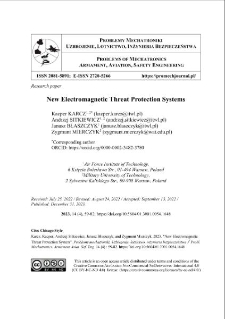Nasza Biblioteka Cyfrowa udostępnia 1 868 obiektów cyfrowych
Obiekt
Tytuł: New Electromagnetic Threat Protection Systems ; New Electromagnetic Threat Protection Systems
Tytuł odmienny:
Nowe systemy zabezpieczeń przed zagrożeniami elektromagnetycznymi ; Nowe systemy zabezpieczeń przed zagrożeniami elektromagnetycznymi
Współtwórca:
Andrzej SITKIEWICZ, Janusz BŁASZCZYK, Zygmunt MIERCZYK ; Andrzej SITKIEWICZ, Janusz BŁASZCZYK, Zygmunt MIERCZYK
Abstrakt:
The issues discussed in the article refer to a new category of military operations - electronic warfare (EW). In the context of EW, the high-power microwave (HPM) technology currently enables remote disturbances of operations lasting until the circuit is reset or the electronic system is destroyed. The article examines the problem of protection and defence against using HPM pulses. The research used a compact HPM generator developed at the Polish National Centre for Nuclear Research. It has a power of 3MW, an operating frequency of 2.9 GHz and a 3 μs pulse duration, emitted with a repetition rate of 1, 50, 100 and 250 Hz. The developed HPM pulse protection systems were subjected to intense field exposure in the open space of the training ground, in its land and sea sections, and in the circuit with a reverberation chamber. The distribution of the generated field on each measurement station was tested using a high-power D-dot probe, from which the data was transferred to the recording system via an optical fibre link. In all cases, this distribution turned out to be repetitive. The field probe with a logger was used for measurements inside composite structures. Unprotected electronic systems in hobby drones, mobile phones, cameras and systems using sensors based on micro-mechanical units were exposed. An analysis was conducted to check the operation of electronic circuits, effects caused and phenomena occurring during exposures to intense microwave radiation. It was found that the developed system meets the design assumptions in conditions similar to actual exposure to HPM weapons. Screening efficiency has been determined for various spatial configurations of radiation beam incidence. The presented systems for the protection and defence against the effects of HPM weapons implemented in the technology of composite hybrid absorbers enable effective elimination of electromagnetic pulse effects.
;
The issues discussed in the article refer to a new category of military operations - electronic warfare (EW). In the context of EW, the high-power microwave (HPM) technology currently enables remote disturbances of operations lasting until the circuit is reset or the electronic system is destroyed. The article examines the problem of protection and defence against using HPM pulses. The research used a compact HPM generator developed at the Polish National Centre for Nuclear Research. It has a power of 3MW, an operating frequency of 2.9 GHz and a 3 μs pulse duration, emitted with a repetition rate of 1, 50, 100 and 250 Hz. The developed HPM pulse protection systems were subjected to intense field exposure in the open space of the training ground, in its land and sea sections, and in the circuit with a reverberation chamber. The distribution of the generated field on each measurement station was tested using a high-power D-dot probe, from which the data was transferred to the recording system via an optical fibre link. In all cases, this distribution turned out to be repetitive. The field probe with a logger was used for measurements inside composite structures. Unprotected electronic systems in hobby drones, mobile phones, cameras and systems using sensors based on micro-mechanical units were exposed. An analysis was conducted to check the operation of electronic circuits, effects caused and phenomena occurring during exposures to intense microwave radiation. It was found that the developed system meets the design assumptions in conditions similar to actual exposure to HPM weapons. Screening efficiency has been determined for various spatial configurations of radiation beam incidence. The presented systems for the protection and defence against the effects of HPM weapons implemented in the technology of composite hybrid absorbers enable effective elimination of electromagnetic pulse effects.
Miejsce wydania:
Warszawa
;
Warszawa
Wydawca:
Wojskowa Akademia Techniczna ; Wojskowa Akademia Techniczna
Data utworzenia:
Data złożenia:
Data akceptacji:
Data wydania:
Rozmiar:
Identyfikator:
oai:ribes-88.man.poznan.pl:2689
Sygnatura:
doi:10.5604/01.3001.0054.1648 ; doi:10.5604/01.3001.0054.1648
ISSN elektroniczny:
ISSN drukowany:
Język:
Licencja:
kliknij tutaj, żeby przejść ; kliknij tutaj, żeby przejść
Właściciel praw:
Wojskowa Akademia Techniczna ; Wojskowa Akademia Techniczna
Strona początkowa:
Strona końcowa:
Tom:
Czasopismo:
Słowa kluczowe:
unmanned aerial vehicles, electronic warfare, microwave directed energy weapons, electromagnetic compatibility ; unmanned aerial vehicles, electronic warfare, microwave directed energy weapons, electromagnetic compatibility
Kolekcje, do których przypisany jest obiekt:
Data ostatniej modyfikacji:
16 paź 2025
Data dodania obiektu:
16 paź 2025
Liczba wyświetleń treści obiektu:
0
Wszystkie dostępne wersje tego obiektu:
https://ribes-88.man.poznan.pl/publication/3022
Wyświetl opis w formacie RDF:
Wyświetl opis w formacie OAI-PMH:
| Nazwa wydania | Data |
|---|---|
| New Electromagnetic Threat Protection Systems | 16 paź 2025 |

